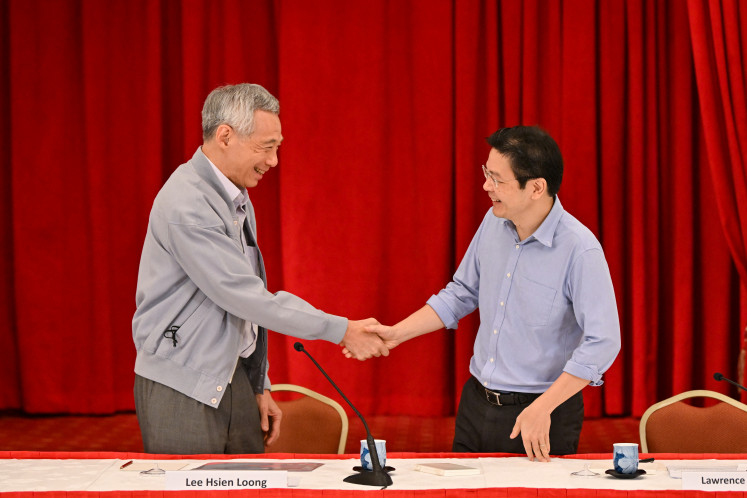Urban farmers withstand floods, pests to tend paddy fields
The sun gently touched a paddy in the middle of a dense neighborhood on a Thursday afternoon in Rorotan village, Cilincing district, North Jakarta, highlighting the different colors of the paddy — green on some fresh blocks and golden on others that were ready to harvest
Change Size

T
span>The sun gently touched a paddy in the middle of a dense neighborhood on a Thursday afternoon in Rorotan village, Cilincing district, North Jakarta, highlighting the different colors of the paddy — green on some fresh blocks and golden on others that were ready to harvest.
“After it rained, it took days to wait for submerged blocks to return to normal. So, as you can see, some plants are only 10 weeks old,” said Abdul Kadir, the Rorotan farmer group leader.
Recent floods have caused not only a delay in the rice planting season, Abdul said, but also an abundance of pests in the paddies and less efficient rice production.
“From 2014, there have always been rats in every planting season. But it is only during the flood season like this that many of them come out of their holes for fear of sheltering in the holes. They only cause trouble in the plantation area,” he added.
Even though poison bait has been spread on the ground, in the worst case, 50 percent of rice plants can fail. “As a result, some farmers choose to plant water spinach if their paddy blocks are badly attacked,” Abdul said.
The Rorotan paddies were among many other fields that survived the city’s rapid development and urbanization, yet they continued to decrease in size as time passed. From about 1,600 hectares in the 1980s, the total size of the Rorotan paddy fields is now less than 400 ha.
Some parts of the fields have been taken for several infrastructure projects, including the ongoing construction of the city’s zero-rupiah down payment low-cost apartment complex, a flagship program of Governor Anies Baswedan.
Other projects cutting down the total size of the Rorotan paddy fields are an artificial reservoir a low-cost rental apartment (Rusunawa) with 1,020 units and an integrated child-friendly public space (RPTRA).
Moreover, most of the remaining Rorotan paddy fields are controlled by two infrastructure development companies, leaving only less than 10 percent still owned by locals.
Zaenal Arifin, who is among nearly 270 farmers in Rorotan, said the companies had allowed farmers to rent the land for around Rp 3 million (US$217.83) every harvest season, although the price could be lower depending on the amount of production.
Due to floods and rat attacks, rice production there could drop dramatically from normally 9 tons per ha to only 4 tons — where every 1 ton of rice was sold for Rp 4 million to distributors, according to Zaenal.
He said that 75 percent of the profits from sales was usually allocated to purchase fertilizer and pesticide, pay rent to developers and hire local farm laborers.
“Keep in mind that the rest of it is used for living during one harvest season, which means about five months. That’s far from enough,” Zaenal said.
Zaenal said many farmers had a side job as construction workers after harvest seasons while they waited for new rice plants to ripen.
While paddy fields were gradually taken up for development projects considered to have higher economic value, the city has regularly participated in big harvest seasons to encourage public awareness of domestic rice
consumption.
This year’s big harvest in Rorotan was kicked off by Jakarta Maritime, Agriculture and Food Security Agency head Darjamuni and North Jakarta Deputy Mayor Ali Maulana Hakim on Jan. 22. Darjamuni said at that time that the remaining rice fields in Jakarta were a valuable asset for farmers to make a living.
Statistics Indonesia's Jakarta Office has recorded that rice fields across the city have been shrinking in the past decade from 1,098 ha in 2011 — 593 ha of which were in North Jakarta — to 895 ha in 2013, 653 ha in 2015 and 571 ha in 2019.
The remaining rice fields are mainly located in Rorotan and Marunda in North Jakarta, relying on irrigation from the East Flood Canal and Tambun Rengas River.









